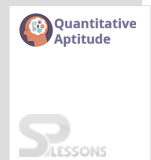 Introduction
Introduction
What is Quantitative Aptitude test?
Quantitative Aptitude is one of the prominent competitive aptitude subjects which evaluates numerical ability and problem solving skills of candidates. This test forms the major part of a number of important entrance and recruitment exams for different fields. The Quantitative Aptitude section primarily has questions related to the Simplification, Numbering Series, and Compound Interest, etc.
A candidate with quantitative aptitude knowledge will be in a better position to analyse and make sense of the given data. Quantitative Aptitude knowledge is an important measure for a prospective business executive's abilities.
The article SSC CPO Quantitative Aptitude Quiz 10 provides Quantitative Aptitude questions with answers useful to the candidates preparing for Competitive exams, Entrance exams, Interviews etc. The article SSC CPO Quantitative Aptitude Quiz 10 will assist the students to know the expected questions from Quantitative Aptitude.
 Quiz
Quiz
1. Three unbiased coins are tossed. What is the probability of getting at least 2 tails?
- 0.75
B. 0.5
C. 0.25
D. 0.2
- A. [latex]\frac{9 }{25}[/latex]
B. [latex]\frac{9 }{50}[/latex]
C. [latex]\frac{18 }{25}[/latex]
D. None of these
- A. [latex]\frac{17 }{52}[/latex]
B. [latex]\frac{8 }{13}[/latex]
C. [latex]\frac{4 }{13}[/latex]
D. [latex]\frac{1 }{13}[/latex]
- A. [latex]\frac{8 }{35}[/latex]
B. [latex]\frac{34 }{35}[/latex]
C. [latex]\frac{27 }{35}[/latex]
D. None of these
- A. 6 hours
B. 9 hours
C. 12 hours
D. 15 hours
1. Two pipes can fill a tank in 10 and 14 minutes respectively and a waste pipe can empty 4 gallons per minute. If all the pipes working together can fill the tank in 6 minutes, what is the capacity of the tank?
- A. 120 gallons
B. 240 gallons
C. 450 gallons
D. 840 gallons
- A. 35 hrs
B. 70 hrs
C. 180 hrs
D. 300 hrs
- A. 12 hrs
B. 30 hrs
C. 44 hrs
D. 60 hrs
- A. 6 hrs
B. 7 hrs
C. 8 hrs
D. 14 hrs
- A. 3 hrs
B. 7 hrs
C. 12 hrs
D. 20 hrs
1. 6, 12, 20, 30, 42, 54, 72, 90, 110
- A. 20
B. 42
C. 54
D. 90
- A. 12756
B. 2123
C. 424
D. 34
- A. 25
B. 28
C. 34
D. 41
- A. 9
B. 11
C. 14
D. 25
- A. 3
B. 7
C. 14
D. 17





